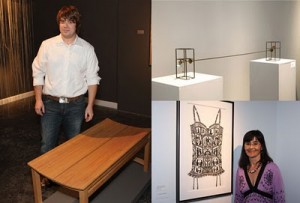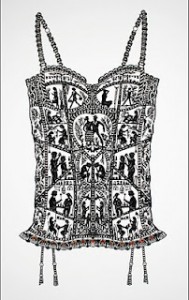We do! So, we took some time to talk with the three award winners and wanted to share a little more about the pieces that won.

First up, Clark Kellogg is currently an artist-in-residence at HCCC and won an award-of-merit for Garden Bench.
In your artist statement you talk about the importance of material, in the case of Garden Bench why did those pieces become a bench rather than a cabinet?
Sometimes my furniture starts with the wood and ends with the piece. In the case of Garden Bench, the opposite occurred. Here I found pieces of wood to fit with the concept and design of the bench.
Why do you choose to make furniture?
I love making things with wood. I want to make something quiet and friendly that will become a part of someone’s home and for me that is found making furniture. I believe it is important to have your interaction with a space be positive and furniture can really determine how you interact with space.
Also creating interactive pieces, Gary Schott is Chair of the Metals department at the Southwest School of Art, and won an award-of-merit for Eskimo Kisser #3. Below is a video of the piece.
Can you talk about the importance of interaction in your work, specifically is Eskimo Kisser #3 meant to interact with two people?
Yes, this piece is meant for two people to interact with. I’ve created others that focus on the importance between the intimate experience between the piece and the person but this is an object for two people. I intend for the devices to be playful and provide a cheeky reaction to modern technology. In a sense, it is akin to how texting provides a technological interaction or interface between individuals, but here it is an object reminiscent of nostalgic toys.
Are people meant to actually touch noses with the piece and how did that dictate your material choices?
Yes, your nose is supposed to touch and so material choices were very important. I tried out many different materials and wanted to find something that was desirable for someone to touch with their nose. I had an “a-hah” moment when someone reintroduced me to needle felting.
The third award-of-merit winner was Catherine Winkler Rayroud for her paper-cut piece, Mama Never Told Me.

What narrative are you creating in the imagery in your piece, Mama Never Told Me?
This piece is very personal and illustrates the examples I was given about a woman’s place in society while growing up in Switzerland. There were certain things my Mother would say but do differently. For instance she would say a woman shouldn’t study because she won’t find a husband, but then I saw how she would write books in her spare time and be unhappy that she couldn’t find more time for these activities. This piece documents the personal journey I went through as a girl becoming an adult and the awakening I had after coming to the United States ten years ago. I often wonder what would be different if I would have been able to grow up here, would things have been different?
For those who aren’t familiar with paper-cutting, can you explain the process?
All of the paper-cuts are done from one sheet of paper with nail scissors and sometimes an exacto-knife. In this piece, I only used nail scissors. Initially I fold the sheet in half to cut the symmetrical images. Then I unfold the paper to cut the asymmetrical images, the difference in the mirror images is meant to be playful, the viewer can try and find the differences.

